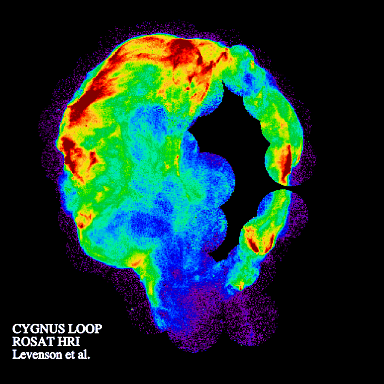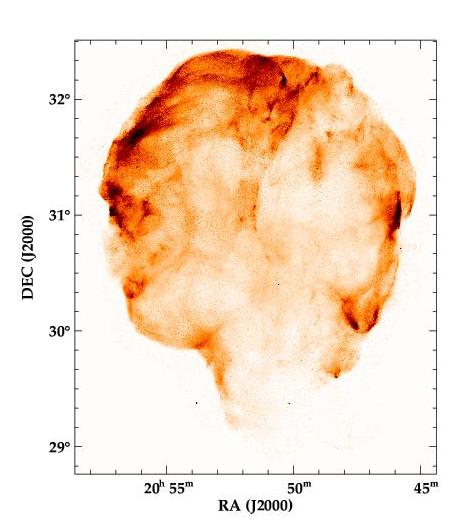Images of the Cygnus Loop
This supernova remnant in the constellation Cygnus, known as the Cygnus Loop, is roughly 20,000 years old. It is generally circular in shape except for a break-out towards the south. In addition, there are many bright, filamentary structures. The ROSAT PSPC observation has allowed the temperature and density structure to be studied on a fine angular scale.

(Credit: S. L. Snowden)
Figure a) of the PSPC plate shows the hard band (0.5-2.0 keV) mosaic of the
Cygnus Loop and Figure b) shows the soft band (0.1 - 0.3 keV). (In all of
these figures, purple and blue indicate low values while yellow and red
indicate high values.) While the general structure in the two bands is
reasonably similar, there are certain differences. This is easily seen in
Figure c) which shows the hard/soft band ratio. In general, the interior
of the Loop is harder and therefore hotter than the edge. This type of
temperature gradient is consistent with what is expected. Figure d) shows
the exposure time of the PSPC mosaic.
Get the high resolution (200 dpi) TIFF format version, or the high resolution Soft Band image.

(Credit: Levenson et al.)
The HRI image better shows the
angular structure of the Cygnus Loop. Even with this image some of the
fine-scale structure is not resolved (both because of the coarse angular
binning and through insufficient event statistics).
Get the high resolution (200 dpi) TIFF format version.


(Credit: Levenson et al.)
Get the high resolution (200 dpi) TIFF format version of the color image.
Get the high resolution (300 dpi) TIFF format version intensity image. Curator:
HEASARC Guest Observer Facility
Please use the Feedback link if you have questions on ROSAT.

